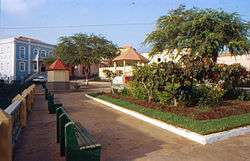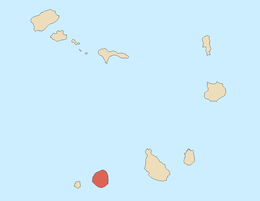São Filipe, Cape Verde
| São Filipe | |
|---|---|
| Settlement | |
|
Square in São Filipe | |
 São Filipe | |
| Coordinates: 14°53′42″N 24°29′53″W / 14.895°N 24.498°WCoordinates: 14°53′42″N 24°29′53″W / 14.895°N 24.498°W | |
| Country | Cape Verde |
| Island | Fogo |
| Municipality | São Filipe |
| Civil parish | Nossa Senhora da Conceição |
| Population (2010)[1] | |
| • Total | 8,122 |
São Filipe (Portuguese for "Saint Philip", Cape Verdean Creole: San Filipi) is a town on the west coast of the island of Fogo, Cape Verde. It is the capital of the island, and the seat of the São Filipe Municipality. The island's airport, São Filipe Airport, is located on the southeastern edge of the town. The town's elevation is 20 meters and the area is slopey ranging up to 100 meters in the easternmost part. Two streams surround the town center.
History
São Filipe was founded in the 16th century and is considered to be the second oldest town in Cape Verde after Ribeira Grande, but a town charter was not granted before 1922.[2] In 1655 São Filipe was destroyed by Flemish pirates.[3]
Sights
- The old city center, called Bila Baxo, is about 40 m above the sea. It is known for its colonial architecture. Since 2000, many houses have been renovated. Many houses have a colourful or richly-decorated façade, wooden balconies or bay windows. In addition to picturesque streets with smaller colonial houses there are about 50 representative mansions to be seen. São Filipe was proposed to be inscribed on the list of World Heritage Sites because of its historic colonial buildings. They are one of eight sites that are on the tentative list of UNESCO's World Heritage Sites, it has been nominated, no date has been set.
- One of the most representative buildings is the city hall (Camara Municipal) which was built in 1928.[4] It is at a sightworthy place called Praça 12 de Setembro where a small park and a wooden pavilion are worth a visit.
- The most important catholic church of the town is Nossa Senhora da Conceição which was built in a comparatively simple style at the end of the 19th century.[5] The church with its two impressive clock towers was renovated several times. The last renovation was completed in 2007. Opposite the church there are several well-preserved colonial houses dating from the 18th century.
- The Market Hall is at the border of Bila Baxo to the more modern part of the city at Praca Francisco de Assis, the busiest place. The most important bus stop and the post office are here as well.
- The Museum Casa da Memória is at Praça 12 de Setembro in a merchant's house which was built in 1820. The neighbouring house is the municipal museum (Museu Municipal). In its inner court several endemic plants of Fogo, some of which are endangered species, were planted, e.g. Crabo bravo (Erysimum caboverdiana) and Língua de vaca (Echium vulcanorum). A small house (Funco) was rebuilt in the traditional style using volcanic stones. A part of the pavement of the inner court consists of basalt stones.
- The historic place Praça Serpa Pinto is in the northwest of the center about 40 m above the beach Praia da Bila consisting of black volcanic sand. There are several colonial houses, monuments and a small parc. The view point Miradouro da Bila Baxo in the northern part of the place offers a beautiful view of the beach and the neighbouring island of Brava.
- A part of the fortress Fortim Carlota dating from 1667 is preserved in the southern part. An impressive canon can be seen in front. The building was used as a prison until 2005.[5]
- In the south of the center, the old cemetery Antigo Cemitério, which was used until the end of the 20th century,is worth a visit. There are several graves in a classic style dating from the 19th century.
- Outside the historic city center, Praça Alberto da Silva, a rectangular place with a small park and a chapel in a typical residential area seldom visited by tourists, is worth a visit. There are several shops, a bakery and a small internet café. The place offers a beautiful view of a part of the city and its surroundings.
Churches

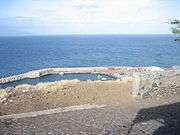
Apart from Nossa Senhora da Conceição, the oldest Catholic church, there are a sightworthy chapel at Praça Alberto da Silva, a New Apostolic Church and two wards of the The Church of Jesus Christ of Latter-day Saints.
Beaches
Praia da Bila, a black beach, is 40 m below the city center. It is not very clean, and on many days the sea is very rough.[4]
The inhabitants of the city prefer the beach at the harbour Porto de Vale de Cavaleiros, about 4 km in the north of Sao Filipe. In spite of the harbour, the water is cleaner and the sea is not so rough.[5] The most popular beach of the island is Ponta da Sallina in São Jorge.
Demography
| Population of the town of São Filipe (1980–present) | ||
|---|---|---|
| 1980[6] | 1990[6] | 2010[1] |
| 4,370 | 5,616 | 8,112 |
Climate
Its climate is warmer than the higher parts of the island and the same as the lower parts of the country. It is a little humid than the upper areas. The average temperature is from 19 to 29 °C (66–84 °F), the highest is 29 °C in October and the lowest is 18.7 °C in February. Average rainfall is 272 millimeters, the highest is 121 mm in September and the lowest is without a single precipitation between the months of March and June.
| Climate data for São Filipe,20-180 metres ASL | |||||||||||||
|---|---|---|---|---|---|---|---|---|---|---|---|---|---|
| Month | Jan | Feb | Mar | Apr | May | Jun | Jul | Aug | Sep | Oct | Nov | Dec | Year |
| Average high °C (°F) | 25.6 (78.1) |
25.6 (78.1) |
26.2 (79.2) |
26.7 (80.1) |
27.1 (80.8) |
27.8 (82) |
28.4 (83.1) |
28.7 (83.7) |
29.1 (84.4) |
29.0 (84.2) |
28.6 (83.5) |
26.4 (79.5) |
27.4 (81.3) |
| Daily mean °C (°F) | 22.3 (72.1) |
22.1 (71.8) |
22.6 (72.7) |
23.0 (73.4) |
23.7 (74.7) |
24.3 (75.7) |
25.1 (77.2) |
25.7 (78.3) |
26.2 (79.2) |
26.3 (79.3) |
25.2 (77.4) |
23.5 (74.3) |
24.2 (75.6) |
| Average low °C (°F) | 19.1 (66.4) |
18.7 (65.7) |
19.0 (66.2) |
19.4 (66.9) |
20.3 (68.5) |
20.8 (69.4) |
21.8 (71.2) |
22.8 (73) |
23.3 (73.9) |
23.7 (74.7) |
21.9 (71.4) |
20.6 (69.1) |
21.0 (69.8) |
| Average rainfall mm (inches) | 3 (0.12) |
2 (0.08) |
0 (0) |
0 (0) |
0 (0) |
0 (0) |
14 (0.55) |
81 (3.19) |
121 (4.76) |
35 (1.38) |
11 (0.43) |
5 (0.2) |
272 (10.71) |
| Source: Climate-Data.ORG[7] | |||||||||||||
International Relations
São Filipe is twinned with:
Gallery
-
Church Nossa Senhora da Conceição.
-

Praça Serpa Pinto.
-

Colonial architecture.
-

Colonial architecture.
-

Colonial architecture.
-

Colonial mansion (Sobrado).
-
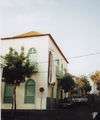
Museum.
-

Traditional hut in the museum.
-
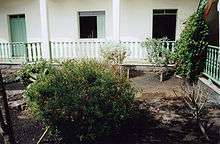
Endemic plants in the inner court of the museum.
-

Fortress Fortim Carlota.
-

Praça Francisco d'Assis.
-

Praça Alberto da Silva.
-

Chapel at Praça Alberto da Silva.
-

New Apostolic Church.
-

Beach and old cemetery.
References
- 1 2 "2010 Census results". Instituto Nacional de Estatística Cabo Verde (in Portuguese). 17 March 2014.
- ↑ Pitt Reitmeier: Cabo Verde - Kapverdische Inseln, p. 386. Bielefeld 2009.
- ↑ Ingrid und Peter Kirschey: Kapverden, p. 156. Köln 2009
- 1 2 Rolf Osang. Kapverdische Inseln, p. 134-135. Köln 2001.
- 1 2 3 Susanne Lipps: Kapverdische Inseln, p. 253-254. Ostfildern 2009.
- 1 2 citypopulation.de
- ↑ http://en.climate-data.org/location/3105/. Retrieved 5 January 2014. Missing or empty
|title=(help)
External links
| Wikimedia Commons has media related to São Filipe (Cape Verde). |
-
 São Filipe travel guide from Wikivoyage
São Filipe travel guide from Wikivoyage - Informations about Sao Filipe, capital of the Island of Fogo, Cape Verde
